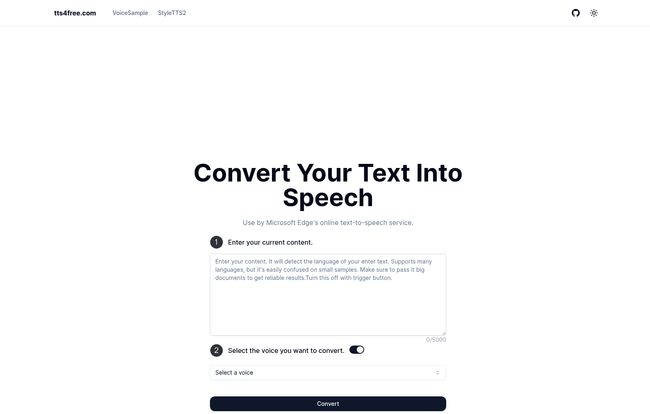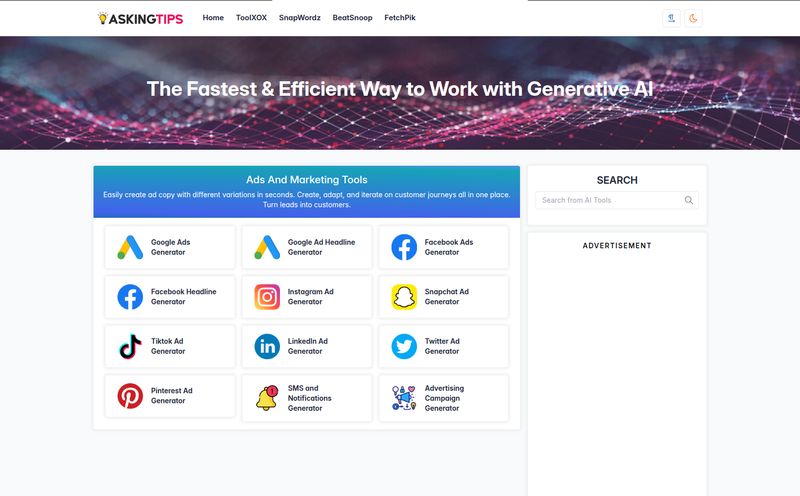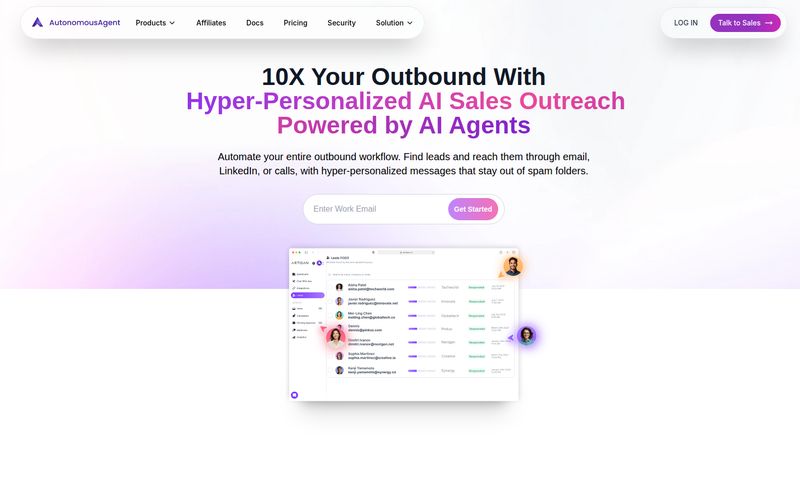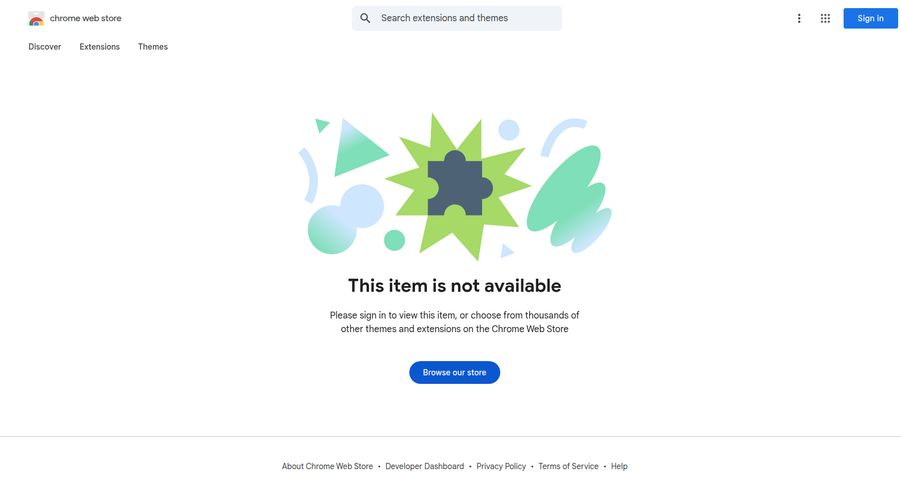In the world of content creation and digital marketing, we're all looking for that magic bullet. That one tool that’s powerful, easy to use, and—here's the kicker—doesn't cost a fortune. I’ve spent more hours (and dollars) than I care to admit on subscription services for everything from keyword research to video editing. So when I stumble across something that claims to be completely free, my inner skeptic immediately sits up and pays attention. Is it really free? Or is it “free” with a thousand hidden asterisks?
That was my exact thought process when I first heard about TTS4Free. The name itself is pretty bold. Text-to-speech for free. No beating around the bush. As someone who's constantly creating short-form video content, podcasts, and accessibility-friendly versions of my blog posts, a reliable TTS tool is a staple in my workflow. But the good ones often come with a monthly fee. So, I decided to take TTS4Free for a spin. I cleared my afternoon, grabbed a coffee, and prepared to be either thoroughly impressed or bitterly disappointed. Here’s what I found.
So What Is TTS4Free Anyway?
At its core, TTS4Free is exactly what it says on the tin: a free, web-based tool that converts your text into spoken audio. It’s incredibly straightforward. You visit the website, paste your text, and get an audio file back. Simple. But what’s going on under the hood is a bit more interesting for us tech nerds. The platform is powered by Microsoft Edge's online text-to-speech service, which is known for its surprisingly natural and human-like voices. The whole thing is built on modern web tech like Next.js and utilizes a project called `edge-tts` to make the magic happen.
This isn't some clunky, robotic voice generator from the early 2000s. You know the ones I'm talking about—they sound like a bored GPS giving you directions to nowhere. Because it's tapping into Microsoft's powerful AI, the quality is genuinely impressive for a tool that costs nothing. It supports a whole bunch of languages, which immediately caught my eye as I often work with international clients.
A Walkthrough of My First Experience
When you land on the TTS4Free homepage, you're not bombarded with ads, pop-ups, or confusing menus. It’s just… clean. A breath of fresh air, honestly. The entire process is broken down into two simple steps laid out right in front of you.
Step 1: Paste Your Content.
There's a big, inviting text box waiting for you. The site mentions it can auto-detect the language, but suggests that for smaller bits of text, it can get confused. Fair enough. I decided to test it with a paragraph from this very article. There’s a character counter at the bottom, maxing out at 5000 characters. More on that later.
Step 2: Choose Your Voice.
Right below the text box is a dropdown menu for selecting a voice. When you first load the page, you have to paste your text, and then the tool offers you the relevant voices for the detected language. I pasted in some English text, and a list of English voices (US, UK, Australian accents, etc.) popped up. I picked one that sounded interesting and hit the big 'Convert' button.

Visit TTS4Free
And that was it. No loading screen that feels like it’s taking a decade. Within seconds, a little audio player appeared, and I could play back the generated speech. The speed was shocking, in a good way. It's like the vending machine of TTS tools—quick, simple, and gets you what you need on the spot without any fuss.
The Good Stuff: What I Genuinely Liked
After playing around with it for a while, a few things really stood out. First and foremost, the price. It's free. Not “freemium,” not a “free trial.” Just free. In an industry where every service wants a piece of your monthly budget, this is a massive win. You don't even need to create an account or hand over your email address. The privacy-conscious part of me did a little happy dance. You can just show up, use the service, and leave. No strings attached.
The multi-language support is another huge plus. I ran some tests with Spanish and French text for a couple of client projects I’m working on, and the tool handled them perfectly, offering a range of native-sounding voices for each. This makes it incredibly versatile for anyone creating content for a global audience. And the ease of use cannot be overstated. I could probably teach my grandma to use this tool in under a minute. It’s that intuitive.
Where It Could Be Better (Let's Be Fair)
Now, no tool is perfect, especially a free one. It’s important to go in with realistic expectations. The most obvious limitation is the 5000-character cap. For short scripts, social media posts, or proofreading a few paragraphs, it’s perfectly fine. But if you’re looking to convert an entire chapter of a book or a long-form blog post, you'll have to do it in chunks. It's a bit of a hassle, but for a free service, it’s a reasonable trade-off. It prevents people from overloading their system, which I get.
While the voice quality is great, the variety of voices might not be enough for some. If you’re a big brand looking for a very specific, unique voice for all your marketing materials, you might still need a premium, paid service that offers hundreds of options or custom voice cloning. TTS4Free provides a solid selection, but not an endless one. Also, and this is a given, you need an internet connection. There's no offline mode, so if your Wi-Fi is spotty, you're out of luck.
Who Is This Tool Actually For?
So, who should have TTS4Free bookmarked? In my opinion, it’s a fantastic utility for a surprisingly wide range of people.
- Content Creators: Need a quick voiceover for a YouTube Short, a TikTok video, or an Instagram Reel? This is your tool. It's fast enough to keep up with the demands of social media content production.
- Students: This is an amazing study aid. Turn your notes or textbook chapters (in 5000-character chunks) into audio files to listen to while you're at the gym or on the bus. It's also great for proofreading your own essays—hearing your words read aloud is one of the best ways to catch typos and awkward phrasing.
- Developers and UI/UX Designers: Need to quickly test how some instructional text will sound in an app or on a website? This is a perfect way to generate placeholder audio without any setup.
- Anyone with Accessibility Needs: For individuals with visual impairments or reading difficulties like dyslexia, this tool can be a simple way to consume written content on the web.
It's not designed to be the end-all-be-all TTS solution for a massive corporation, but it's an incredibly powerful tool for individuals and small teams.
The Big Question: What About Pricing?
I know I've mentioned it a few times, but it bears repeating in its own section because it's the tool's most defining feature. TTS4Free is 100% free. There are no hidden tiers, no premium features behind a paywall, and no subscription plans. The creator seems to run it as a project leveraging powerful existing technologies, which is why they can offer it at no cost. It’s a refreshing change of pace.
Frequently Asked Questions (FAQ)
I figured you might have some of the same questions I did, so here are some quick answers.
Is TTS4Free really, truly free?
Yes. I looked for a catch and couldn't find one. It's completely free to use. No sign-up, no credit card, nothing.
Do I need to create an account to use it?
Nope! That's one of its best features. You can use it anonymously right from the homepage.
What languages does TTS4Free support?
It supports a wide variety of languages by leveraging Microsoft's TTS engine. You'll find voices for major world languages like English (with different accents), Spanish, French, German, Chinese, Japanese, and many more.
How natural do the voices sound?
Surprisingly natural. They're not robotic at all. They use neural AI to generate speech that has realistic intonation and pacing. They're excellent for most general purposes.
Is there a limit to how much text I can convert?
Yes, there's a 5000-character limit per conversion. You can run multiple conversions, but you'll need to break up longer documents into smaller sections.
Can I use the generated audio for commercial projects?
This is the tricky one. Since the tool is a front-end for Microsoft's service, the usage rights would technically be governed by Microsoft's terms of service. For small-scale commercial use like social media videos, it's probably fine, but for a large-scale commercial product, I would advise caution and perhaps opting for a paid service with explicit commercial licensing for peace of mind.
My Final Verdict on TTS4Free
So, am I impressed? Absolutely. TTS4Free has earned a permanent spot in my browser's bookmarks bar. It's not going to replace the high-end, feature-rich paid platforms for every single task, especially for long-form narration or unique brand voices. But that's not its goal.
It’s the perfect “in a pinch” tool. It’s the quick, no-nonsense solution for 90% of the daily text-to-speech needs that pop up for content creators, students, and developers. It's fast, the quality is solid, and its barrier to entry is literally zero. In a world saturated with complex tools and subscription fatigue, the beautiful simplicity of TTS4Free is its greatest strength. Give it a try; you've got nothing to lose. Literally.
Reference and Sources
- The tool itself: TTS4Free.com
- The underlying JavaScript framework: Next.js
- Information on the TTS technology: Microsoft Azure Text to Speech



